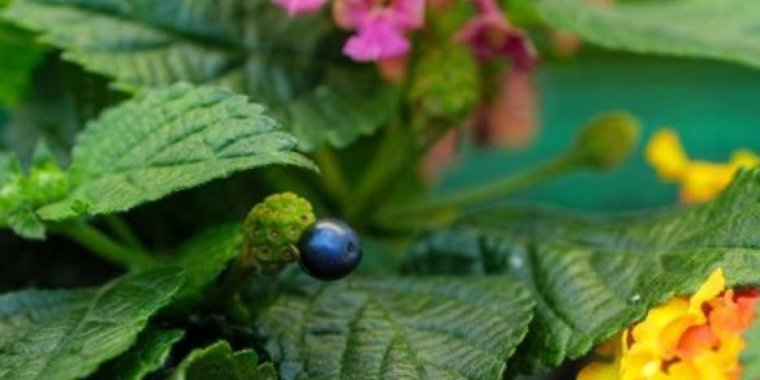| News / Science News |
Pigment or optical illusion? What makes this berry blue
Miranda Sinnott-Armstrong was walking down Pearl Street in Boulder, Colorado, when something caught her eye: a small, particularly shiny blue fruit, on a shrub known as Lantana strigocamara.

Lantana strigocamara creates its blue-colored fruits with layered fat molecules. Photo: Patrick Campbell/CU Boulder
While its tiny clusters of pink, yellow and orange flowers and blue berries commonly adorn the pedestrian mall in spring, city workers were ripping these common Lantanas out to prepare for the winter season.
Sinnott-Armstrong, an ecologist and evolutionary biologist at the University of Colorado Boulder, asked if she could take a specimen back to the lab. She wanted to know what made these berries so blue.
The study confirms L. strigocamara as the second documented case of a plant creating blue-colored fruits with layered fat molecules. Sinnott-Armstrong and her co-authors also published the first such documented case.
"This research shows us that plants, in addition to animals, use structural color to convey the color blue as an important piece of information to other organisms," said Daniel Marenda, a program director in NSF's Division of Biological Infrastructure.
"The work underscores the importance of color, and the different ways organisms have evolved to express it, in the biological world."
The two plants are among only six in the world known to make their fruits' hues using a trick of the light known as structural color. But Sinnott-Armstrong has a hunch there are more.
Structural color is very common in animals. It's what gives peacocks' otherwise brown feathers their brilliant greens, and many butterflies their bright blues. But this optical illusion of sorts is much rarer in plants.
To create their unique color, the blue fruits use microscopic structures in their skin to manipulate light and reflect the wavelengths our eyes perceive as blue, giving them a distinctive metallic finish.
Pigmented color does the opposite, absorbing select visible wavelengths of light. That means structurally colored berries have no color themselves; if you were to squish them, they would not stain blue.
In fact, if you peel the skin off a Lantana fruit and hold it up to the light, it looks completely translucent. But if you place it against a dark background, it looks blue again, due to the nanostructures on the surface responsible for reflecting the color.
What's unique about L. strigocamara is that it creates the structural color in its skin using layers of lipid molecules, or fats. Viburnum tinus is the only other plant known to do the same thing.
Lantana and Viburnum last shared a common ancestor more than 100 million years ago. The two plants therefore evolved this trait independent of one another.
"It puts us on the hunt for other groups where this happens, because we know it can be done in multiple ways," said Stacey Smith, co-author on the publication and a CU Boulder ecologist and evolutionary biologist. (U.S. National Science Foundation)
YOU MAY ALSO LIKE





